James Lick, the "Generous Miser"
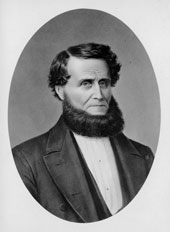
He was an honest, industrious man, of much common
sense, though noted for many eccentricities and whims and in his later years,
of irritable and thoroughly disagreeable temperament....His great and
well merited fame rests on the final disposition of his millions,
which after provision for his relatives, were devoted to various
scientific, charitable, and educational enterprises for the benefit
of the donor's adopted state.
Hubert H. Bancroft in Rosemary Lick's The Generous Miser
"A telescope superior to and more
powerful than any telescope yet made ... and also a suitable
observatory connected therewith ..."
The Story of Lick Observatory begins at
a time of rapid change in the American West. The new transcontinental
railroad had only recently linked the young state of California to the
established centers of science and commerce in the East. The Gold Rush
had left a profoundly changed economy in its wake. Fortunes had been
made, and among those who had reaped the wealth was a thrifty
Pennsylvania Dutchman who had found gold not in the foothills of the
Sierra Nevada, but in the booming real estate market fueled by
California's unprecedented growth.
Even as he lay dying in the sumptuous San Francisco hotel he
had built, James Lick was issuing final orders for the
disposition of his fortune. His largest single bequest would
be for construction of the astronomical observatory that
bears his name. The telescope he envisioned - part high-
visibility scientific enterprise, part monument to himself -
was to be second to none. But first, Lick's own extraordinary
story, from Pennsylvania woodworker to California
millionaire, bears telling.
from James Lick's deed of trust, 1874
Some day, I will own a mill that will make yours
look like a pigsty!
James Lick was born in Stumpstown (now Fredericksburg),
Pennsylvania, on August 25th, 1796, the eldest of seven
children. His father was a skilled woodworker and on his thirteenth
birthday James became his apprentice, learning carpentry and
cabinetmaking under the master's stern and demanding
tutelage. He was a quiet and obedient pupil who, despite any
inward resentment he may have harbored against his father's
severity, strove to achieve the excellence that was expected
of him. In time, his skill became equal to that of his
teacher's.
James might have settled into an unremarkable existence in
Stumpstown, working the family farm and building fine cedar
chests for the local trade, but, at the age of 21, an
ill-starred romance changed the course of his life. Rosemary Lick tells
the story in The Generous Miser, her biography of her great-granduncle:
"He had been keeping company with a girl named Barbara Snavely for some time.
She was the daughter of a local miller and farmer. James was very much in
love with Barbara. One day, she confided to him that she was pregnant.
He became very concerned and planned to do the right thing by marrying her
immediately. However, when he talked to her father the next day, and
asked his permission to marry Barbara, Henry Snavely was indignant at the
very idea of a young apprentice joiner having the temerity to ask for his
daughter's hand in marriage.
'Have you a penny in your purse?' he asked James. Without even waiting
for an answer, he went on. 'When you own a mill as large and costly as
mine, you can have my daughter's hand, but not before.'
An angry James strode from the house, but before he left, he shot back
at the haughty miller, 'Some day, I will own a mill that will make yours
look like a pigsty!'"
Following his disappointment, Lick left Stumpstown. He found
work in Baltimore where he learned the art of piano making,
and before long set up his own shop in New York. In 1821,
after learning that his pianos were being exported to South
America, Lick packed his tools, his workbench, and his few
belongings, and sailed for Argentina, reasoning that by
taking himself to the market he could more quickly build the
fortune he needed to win the hand of his beloved Barbara.
South American Years
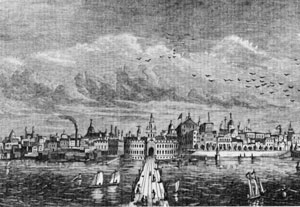 Nineteenth century Buenes Aires.
Lick's South American years - nearly thirty in all - were
prosperous and colorful ones. He established his first
workshop in Buenos Aires where his honesty and fine
craftsmanship soon placed him in high regard. The business
prospered despite chronic - and often violent - political
turmoil.
At first Lick found his new life difficult. He was frequently
ill and was handicapped by his lack of Spanish. He had
arrived during a particularly unstable period and was unhappy
witness to bloody uprisings in the city. In 1825, even with
his business thriving and command of the language attained,
Lick wrote to his father that he was "one minute in the
clouds of heaven and the next in the depths of the sea and
death always before my eyes in ten thousand forms. This is
far from peaceful living", he continued, "and I would not
wish it on my worst enemy."
That same year, leaving his business in the hands of a
trusted man, Lick left for a year's tour of Europe, hoping to
regain health and peace of mind. On the return voyage, his
ship, after nearly sinking in a fearsome storm, was captured
by a Portuguese Man-o-War as it approached Buenos Aires.
Passengers and crew were taken to Montevideo (in present-day
Uruguay) as prisoners of war. Lick's daring escape on foot
finally brought him home, where he found his business much in
need of attention.
Lick immediately set about reestablishing his fortune. He
soon restored his piano business to its former prosperity,
and began a lucrative trade in furs. By 1832 he felt that he
had accumulated enough money to make the long hoped-for trip
back to Stumpstown, to at last claim the bride he expected to
find waiting. However, despite the $40,000 he carried, Lick
saw neither his would-be bride nor his son. On hearing of her
old lover's imminent return, Barbara, who had married another
man only two years after Lick's departure, had taken their
son John and left Stumpstown. Though James had
corresponded with his family, he had apparently not
communicated his intention to return for Barbara, and no one
had informed him of her marriage.
Nineteenth century Buenes Aires.
Lick's South American years - nearly thirty in all - were
prosperous and colorful ones. He established his first
workshop in Buenos Aires where his honesty and fine
craftsmanship soon placed him in high regard. The business
prospered despite chronic - and often violent - political
turmoil.
At first Lick found his new life difficult. He was frequently
ill and was handicapped by his lack of Spanish. He had
arrived during a particularly unstable period and was unhappy
witness to bloody uprisings in the city. In 1825, even with
his business thriving and command of the language attained,
Lick wrote to his father that he was "one minute in the
clouds of heaven and the next in the depths of the sea and
death always before my eyes in ten thousand forms. This is
far from peaceful living", he continued, "and I would not
wish it on my worst enemy."
That same year, leaving his business in the hands of a
trusted man, Lick left for a year's tour of Europe, hoping to
regain health and peace of mind. On the return voyage, his
ship, after nearly sinking in a fearsome storm, was captured
by a Portuguese Man-o-War as it approached Buenos Aires.
Passengers and crew were taken to Montevideo (in present-day
Uruguay) as prisoners of war. Lick's daring escape on foot
finally brought him home, where he found his business much in
need of attention.
Lick immediately set about reestablishing his fortune. He
soon restored his piano business to its former prosperity,
and began a lucrative trade in furs. By 1832 he felt that he
had accumulated enough money to make the long hoped-for trip
back to Stumpstown, to at last claim the bride he expected to
find waiting. However, despite the $40,000 he carried, Lick
saw neither his would-be bride nor his son. On hearing of her
old lover's imminent return, Barbara, who had married another
man only two years after Lick's departure, had taken their
son John and left Stumpstown. Though James had
corresponded with his family, he had apparently not
communicated his intention to return for Barbara, and no one
had informed him of her marriage.
 The brig Lady Adams.
Disheartened, Lick returned to Buenos Aires, but with
revolution threatening, soon moved to Valparaiso, Chile.
Four years later, again to escape the clouds of war, he moved
to his third and last South American home: Lima, Peru. As
before, his high standards established his good reputation
and his services were soon in great demand.
Lick spent a prosperous decade in Lima, but by 1846 he had
made up his mind to return to North America. Always an avid
reader of newspapers and observer of the political scene, he
had watched the dispute between Mexico and the United States
over Texan sovereignty arise, and had concluded that war was
inevitable. Lick fully expected a U.S. victory and with it
the annexation of California, a territory rich with
opportunity for a man with vision - and capital to back it.
Once having made up his mind, Lick was anxious to leave, but
his mostly Mexican workers had quit to fight in the war which
had broken out in April of 1846, leaving him with a dozen
unfilled orders. In characteristic fashion, Lick remained in
Lima another eighteen months, finishing the pianos with his
own hands. Finally, his obligations discharged, he sailed for
California on the brig Lady Adams in November, 1847.
The brig Lady Adams.
Disheartened, Lick returned to Buenos Aires, but with
revolution threatening, soon moved to Valparaiso, Chile.
Four years later, again to escape the clouds of war, he moved
to his third and last South American home: Lima, Peru. As
before, his high standards established his good reputation
and his services were soon in great demand.
Lick spent a prosperous decade in Lima, but by 1846 he had
made up his mind to return to North America. Always an avid
reader of newspapers and observer of the political scene, he
had watched the dispute between Mexico and the United States
over Texan sovereignty arise, and had concluded that war was
inevitable. Lick fully expected a U.S. victory and with it
the annexation of California, a territory rich with
opportunity for a man with vision - and capital to back it.
Once having made up his mind, Lick was anxious to leave, but
his mostly Mexican workers had quit to fight in the war which
had broken out in April of 1846, leaving him with a dozen
unfilled orders. In characteristic fashion, Lick remained in
Lima another eighteen months, finishing the pianos with his
own hands. Finally, his obligations discharged, he sailed for
California on the brig Lady Adams in November, 1847.
A New Life in California
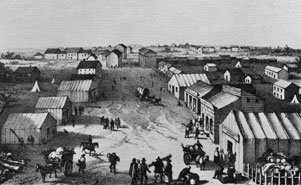 San Francisco at about the time
of Lick's arrival.
Lick arrived in San Francisco in January, 1848, less than a
month before the Treaty of Guadalupe Hidalgo ceded California
to the United States. He brought his tools, his workbench,
and an iron-clad chest containing $30,000 in Peruvian gold.
(Lick's baggage also included 600 pounds of chocolate
purchased from his confectioner neighbor in Lima. The
chocolate sold quickly, and, on Lick's advice, the
confectioner - Domingo Ghirardelli - moved to San Francisco, where
his name is synonymous with the city to this day!)
Lick looked at the hills and mudflats of the little shanty
town with its thousand inhabitants and fine natural harbor,
and saw in it a thriving city and a center of commerce. He
at once began to turn his cash into land. He bought shrewdly
and without hesitation, acquiring thirty-seven lots by mid-March.
Lick's unprecedented buying spree was the talk of San
Francisco, and surely many locals, thinking him a bit
touched, must have been only too glad to take his money.
What Lick and his fellow San Franciscans could not have
foreseen was an event which would change the course of
California history and completely reshape her economy. The
discovery of gold at Sutter's Mill, only seventeen days after
Lick's arrival, would soon give rise to a boom which
catapulted San Francisco's population to twenty thousand in
the next two years.
San Francisco at about the time
of Lick's arrival.
Lick arrived in San Francisco in January, 1848, less than a
month before the Treaty of Guadalupe Hidalgo ceded California
to the United States. He brought his tools, his workbench,
and an iron-clad chest containing $30,000 in Peruvian gold.
(Lick's baggage also included 600 pounds of chocolate
purchased from his confectioner neighbor in Lima. The
chocolate sold quickly, and, on Lick's advice, the
confectioner - Domingo Ghirardelli - moved to San Francisco, where
his name is synonymous with the city to this day!)
Lick looked at the hills and mudflats of the little shanty
town with its thousand inhabitants and fine natural harbor,
and saw in it a thriving city and a center of commerce. He
at once began to turn his cash into land. He bought shrewdly
and without hesitation, acquiring thirty-seven lots by mid-March.
Lick's unprecedented buying spree was the talk of San
Francisco, and surely many locals, thinking him a bit
touched, must have been only too glad to take his money.
What Lick and his fellow San Franciscans could not have
foreseen was an event which would change the course of
California history and completely reshape her economy. The
discovery of gold at Sutter's Mill, only seventeen days after
Lick's arrival, would soon give rise to a boom which
catapulted San Francisco's population to twenty thousand in
the next two years.
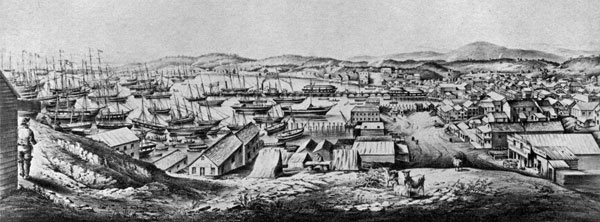 San Francisco about 1850.
Even the conservative Lick was infected with gold fever, but
a week in the mud of the gold fields convinced him that his
future lay not in the glittering metal beneath the soil but
in the land itself. By prompt and judicious investment he
was able to purchase sizeable real estate holdings at a time
when many residents were anxious to sell in order to seek
treasure in the gold-laden foothills. This "buyer's market"
allowed Lick to purchase more land than he might otherwise
have done. While luck certainly played a role in creating
these circumstances, Lick possessed the intelligence,
courage, and capital to take full advantage of the
opportunity.
Now in his mid-fifties, tall, vigorous, and stern, his strong
face framed with a severe beard and a head of thick dark
hair, Lick was an imposing figure. As his wealth and holdings
increased, his interest turned more and more to the land. He
left the management of his San Francisco properties to an
agent, and focused his attention on a large tract of land he
owned near San Jose. He gave rein to his gift for
horticulture, transforming his orchards into some of the
finest in the state and selling produce to the hungry
residents of San Francisco.
San Francisco about 1850.
Even the conservative Lick was infected with gold fever, but
a week in the mud of the gold fields convinced him that his
future lay not in the glittering metal beneath the soil but
in the land itself. By prompt and judicious investment he
was able to purchase sizeable real estate holdings at a time
when many residents were anxious to sell in order to seek
treasure in the gold-laden foothills. This "buyer's market"
allowed Lick to purchase more land than he might otherwise
have done. While luck certainly played a role in creating
these circumstances, Lick possessed the intelligence,
courage, and capital to take full advantage of the
opportunity.
Now in his mid-fifties, tall, vigorous, and stern, his strong
face framed with a severe beard and a head of thick dark
hair, Lick was an imposing figure. As his wealth and holdings
increased, his interest turned more and more to the land. He
left the management of his San Francisco properties to an
agent, and focused his attention on a large tract of land he
owned near San Jose. He gave rein to his gift for
horticulture, transforming his orchards into some of the
finest in the state and selling produce to the hungry
residents of San Francisco.
Eccentric Millionaire
 Lick mill, Santa Clara, CA.
Though 37 years had passed since Lick's angry confrontation
with Henry Snavely, Lick had not forgotten his bitter promise
to the miller. Along the banks of the Guadalupe river, he
built the mill that would make Snavely's "look like a
pigsty." Lick did much of the work himself on the lavish
$200,000 project, which came to be known, for its extravagant
use of the most costly machinery and the finest woods, as
"the Mahogany Mill" and "Lick's Folly."
When the mill was finally completed in 1855, Lick had it
photographed and copies sent to Stumpstown. Though in all
likelihood Henry Snavely was dead by that time, this did not
stop the proud Lick from making good on his promise of thirty-five
years before.
That same year Lick sent for his son John, who, at thirty-
seven, had never met his father. He brought with him the
news that his mother, Barbara, had died four years before.
John remained with his father for eight years, but the
relationship was not an easy one. Though Lick made his son
manager of the mill, he thought him irresponsible and without
ambition.
At first, Lick and his son shared a small cabin. In hopes of
improving their relationship, Lick built a colonial mansion
with a marble fireplace in each of its 24 rooms, but, to his
great disappointment, John preferred the simplicity of the
cabin. Soon Lick himself lost interest in the project. He
never furnished the grand house, sleeping instead on an old
door propped between two nail kegs, and drying fruit from his
orchards on newspapers spread in the empty rooms. In 1863,
John went back to Pennsylvania, returning only when his
father was on his deathbed.
Though known - and sometimes criticized - for his austere
personal habits, Lick was capable of vision on a grand scale.
Late in 1861 he began work on a hotel in San Francisco that
came to be regarded as the finest west of the Mississippi.
The dining room, with its seating for 400, was modeled after one
which Lick had seen 35 years before in the palace at
Versailles. Lick meticulously cut and placed much of the
exquisite wood inlay in the dining room with his own hands.
The magnificent hotel, known as Lick House, was destroyed in
the great San Francisco fire which followed the earthquake of
1906.
Lick mill, Santa Clara, CA.
Though 37 years had passed since Lick's angry confrontation
with Henry Snavely, Lick had not forgotten his bitter promise
to the miller. Along the banks of the Guadalupe river, he
built the mill that would make Snavely's "look like a
pigsty." Lick did much of the work himself on the lavish
$200,000 project, which came to be known, for its extravagant
use of the most costly machinery and the finest woods, as
"the Mahogany Mill" and "Lick's Folly."
When the mill was finally completed in 1855, Lick had it
photographed and copies sent to Stumpstown. Though in all
likelihood Henry Snavely was dead by that time, this did not
stop the proud Lick from making good on his promise of thirty-five
years before.
That same year Lick sent for his son John, who, at thirty-
seven, had never met his father. He brought with him the
news that his mother, Barbara, had died four years before.
John remained with his father for eight years, but the
relationship was not an easy one. Though Lick made his son
manager of the mill, he thought him irresponsible and without
ambition.
At first, Lick and his son shared a small cabin. In hopes of
improving their relationship, Lick built a colonial mansion
with a marble fireplace in each of its 24 rooms, but, to his
great disappointment, John preferred the simplicity of the
cabin. Soon Lick himself lost interest in the project. He
never furnished the grand house, sleeping instead on an old
door propped between two nail kegs, and drying fruit from his
orchards on newspapers spread in the empty rooms. In 1863,
John went back to Pennsylvania, returning only when his
father was on his deathbed.
Though known - and sometimes criticized - for his austere
personal habits, Lick was capable of vision on a grand scale.
Late in 1861 he began work on a hotel in San Francisco that
came to be regarded as the finest west of the Mississippi.
The dining room, with its seating for 400, was modeled after one
which Lick had seen 35 years before in the palace at
Versailles. Lick meticulously cut and placed much of the
exquisite wood inlay in the dining room with his own hands.
The magnificent hotel, known as Lick House, was destroyed in
the great San Francisco fire which followed the earthquake of
1906.
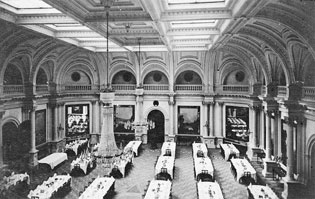 The dining room at Lick House
Another of his grand enterprises - a replica of the iron and
glass conservatory in London's Kew Gardens which he had
ordered from an East Coast firm - was intended as a gift to the
city of San Jose, but when Lick read an article in a local
newspaper criticizing his characteristically shabby dress, he
withdrew the gift, never opening the crates in which it had
arrived. After Lick's death, the impressive structure was
purchased by a group of San Franciscans who assembled it in
Golden Gate Park where it still stands as the beautiful
Conservatory of Flowers.
Lick was widely known for his eccentricity. He showed little
interest in his own comfort or appearance. He was laconic and
taciturn and rarely felt the need to explain himself to those
around him. He was known to test the obedience of his workers
by assigning such tasks as planting trees upside-down. He
enjoyed showing off his orchards and flowers to visitors, but
once, overhearing one of a group of young ladies remark that
she had seen prettier violas in San Francisco, he stranded
them in a field, leaving them to find their own way home.
He could be both generous and miserly, thoughtful and
inflexible. Though he had invited his son to share his life
and fortune, he later all but cut him from his will, citing
John's neglect of his pet parrot. He is said to have offered
a 60-acre field to a stranger for the cost of the fence, but
when the man took a day to decide, Lick told him that because
he had wavered he could no longer have the land at any price.
The dining room at Lick House
Another of his grand enterprises - a replica of the iron and
glass conservatory in London's Kew Gardens which he had
ordered from an East Coast firm - was intended as a gift to the
city of San Jose, but when Lick read an article in a local
newspaper criticizing his characteristically shabby dress, he
withdrew the gift, never opening the crates in which it had
arrived. After Lick's death, the impressive structure was
purchased by a group of San Franciscans who assembled it in
Golden Gate Park where it still stands as the beautiful
Conservatory of Flowers.
Lick was widely known for his eccentricity. He showed little
interest in his own comfort or appearance. He was laconic and
taciturn and rarely felt the need to explain himself to those
around him. He was known to test the obedience of his workers
by assigning such tasks as planting trees upside-down. He
enjoyed showing off his orchards and flowers to visitors, but
once, overhearing one of a group of young ladies remark that
she had seen prettier violas in San Francisco, he stranded
them in a field, leaving them to find their own way home.
He could be both generous and miserly, thoughtful and
inflexible. Though he had invited his son to share his life
and fortune, he later all but cut him from his will, citing
John's neglect of his pet parrot. He is said to have offered
a 60-acre field to a stranger for the cost of the fence, but
when the man took a day to decide, Lick told him that because
he had wavered he could no longer have the land at any price.
Generous Miser
Despite his eccentricities, Lick is best remembered for his
strong will and determination, his ambition and drive, his
honesty and generosity. Yet there lingers about the edges of
these harder qualities, a shade of resignation, even
fatality. Once, while carrying an ox-yoke on his shoulders,
he was overtaken by a friend with a horse and wagon who
offered him a ride. Lick thanked the man but declined. His
friend then asked if he wouldn't at least put the heavy yoke
in the wagon. "So far in life", he replied, "I have born my
yoke patiently, and I will not shirk my duty now".
One evening in his 77th year, alone in the kitchen of his
Santa Clara homestead, Lick collapsed from a severe stroke.
In the morning he was found, alive but helpless, by his
foreman, Thomas Fraser, a man who, years before, had earned a
job by unquestioningly following Lick's orders to stack and
restack a pile of bricks in the rubble of a burnt house. Lick
lived another three years, but never completely regained his
health.
His estates now included, in addition to many properties in
San Francisco and the Santa Clara Valley, holdings on the
shores of Lake Tahoe, a huge ranch in Los Angeles County, and
all of Santa Catalina Island off the southern California
shore. He was among the richest men in a state noted for its
riches.
Lick's infirmity forced him to move to a room in his San
Francisco hotel, where he could be more easily cared for. It
was there that he turned his attention to the disposition of
his fortune, formulating a variety of bequests ranging from
public baths to a home for aging widows, from a generous
donation to an orphanage to one for the prevention of cruelty
to animals, from the foundation of a vocational school to
monuments honoring his parents and grandfather.
Never far from his mind, however, was the monument he wished
to leave to his own memory. At first, Lick wanted to set
aside a million dollars to erect enormous statues of himself
and his parents, so tall as to be visible far out to sea.
This plan was abandoned when a friend pointed out that the
monumental statues would make vulnerable targets in the event
of a naval bombardment. The scheme was replaced by an even
grander one: a pyramid, larger than the Great Pyramid in
Egypt, to be built in downtown San Francisco upon a block
which he entirely owned! But, to the lasting benefit of
science - if not to the San Francisco tourist trade - Lick's
thoughts were turned from pyramids to telescopes.
Several persons have been credited with sparking Lick's
interest in the stars and steering him in the direction of
building an observatory. According to legend, in 1860, Lick
had met a student of astronomy and itinerant lecturer named
George Madeira who had talked to him of the heavens and
impressed him with views through his small telescope. Madeira
is reputed to have told Lick that "If I had your wealth ... I
would construct the largest telescope possible to construct".
Joseph Henry, Secretary of the Smithsonian Institution, who
had met Lick in 1871, also claimed to have guided him towards
a major scientific bequest by holding up the example of his
institution's benefactor, John Smithson.
But the single person most responsible for Lick's eventual
decision to build an observatory was his friend George
Davidson: astronomer, geographer, and President of the
California Academy of Sciences. Davidson often visited the
ailing millionaire in his room at Lick House, and in the
course of their conversations, gently led him to the idea of
his greatest monument.
They discussed science, astronomy, the planets, the rings of Saturn, and
the mountains on the moon. Their talks soon veered to telescopes, and before
long Lick decided to forego his pyramid and instead give his fortune for a
telescope 'superior to and more powerful than any telescope yet made.'
(from Eye on the Sky, Osterbrock, Gustafson, and Unruh).

Text is copyright 1998, Anthony Misch and Remington Stone. Images are copyright University of California and The Mary Lea Shane Archive. The authors are indebted, in particular, to two sources for the material in this essay: Eye on the Sky by Donald Osterbrock, John Gustafson, and W. Shiloh Unruh, University of California Press, 1988, and The Generous Miser by Rosemary Lick, Ward Ritchey Press, 1967.